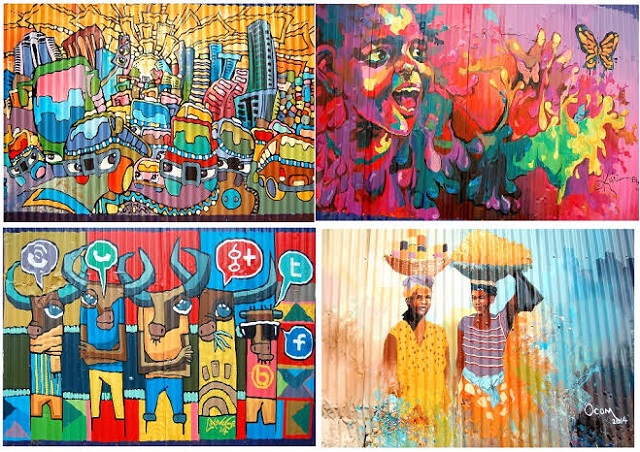
Kampala, Uganda | DOMINIC MUWANGUZI | The Contemporary art world has witnessed an influx of corporate sponsorship in the last two decades which has left a huge debate on the impact of corporate endorsement in the Industry. Corporate sponsorship is a form of marketing in which a company pays for the right to be associated with a project or program. In light of this definition, business corporations partner with galleries or museums to financially support individual artists or specific activities of the respective institution.
On the other hand, the corporation uses this collaboration to promote its respective corporate social responsibility; though most importantly to seek recognition in the eyes of the public. The nature of such a partnership is the reason why there’s a surge in corporate patronage of art where three in five major art activities happening on the global art stage are supported and promoted by influential business Corporations. In Uganda, though the trend has in recent years waned, between the period 2009- 2015, the industry was awash with a host of both international and continental corporations bankrolling art events in the capital, Kampala.
The benefit this collaboration has had on the continent’s art landscape cannot be overlooked. In South Africa where the art industry is highly developed and therefore unrivaled on the African continent, several multinational companies like Standard Bank, Absa Bank and Adidas have worked and invested huge sums of money in the industry. The Standard Bank art gallery fully funded by the premier Bank is located in Johannesburg and routinely provides space for artists to exhibit. Similarly, the Absa L’ Atelier annual artist competition by the banking institution has provided opportunities to hundreds of young artists across the continent to kick start their careers. The ambitious initiative by European business mogul Jochen Zeitz to found the Zeitz Museum of Contemporary Art Africa, (MOCAA) in Cape town South Africa, created unprecedented fortunes for the industry.

In Uganda the annual Sadolin Mabarti Challenge organized by Sadolin Paint provided opportunities to discover new talent in the industry. The prize money awarded to the winners of the contest was a motivation towards their hardwork and creativity which would spur them to new heights. Similarly, both editions of the Mukumbya Musoke Art Awards organized and supported by Mukumbya Musoke Advocates in partnership with Afriart gallery, supported the initiative to discover new talent in the industry. The alumni of the Awards have since launched successful careers for themselves; participating in both local and continental art shows.
But corporate sponsorship has not only been focused towards discovering young artists and providing them opportunities to showcase their art. In 2010, Tullow Oil Company, then working in Uganda, organized an exhibition for artists- some of the best names in the industry- to sell their work to top company executives in the country. The event which was hosted at the Serena hotel in Kampala had about 30 corporate executives attend, view and buy the art on display. Notable artists like Taga Nuwagaba, Joseph Ntensibe, Paulo Akiiki and Ronnex sold works over millions of shillings in the two day event.
This contribution to the industry through sponsorship deals withstanding, this type of patronage always runs into trouble with art critics, art activists and artists. The bad blood between the two fields is premised on the overriding nature of such funding where sometimes money is put at the forefront of art. In other circumstances, the source of money used to fund a particular project or artist has been obtained irregularly. As such, the question which is often fronted in such debate is, is there such a thing as bad money in art? In the article: The ethics of sponsorship in art: Is there such a thing as bad money? Published in ArtReview in December 2018, the author analyzed the different scenarios where corporate companies’ funding was out rightly rejected or protested by artists or art activists in different parts of the world.
The generally held opinion in all these debacles is that corporate sponsorship is an attempt to try to white wash their (corporations) bad practices and an act of preying on the vulnerability of cultural institutions faced with the challenges of privatization. Privatization is a capitalistic vice which is totally dissimilar to the principles of culture. Some critics have thus argued: ‘capital is dirty, culture is pure’ to emphasis the mismatch between the two sectors. Nonetheless, the same critics have gone ahead to contend that the two ‘cannot be disengaged’, a reality we live with today.
The bitter and sweet relationship between the corporate sponsorship and art will always exist. In reality the two need each other to exist and survive in contemporary society with its inevitable capitalistic tendencies. But while such mutual relationship exists, it is critical to draw the boundaries on how far the benevolent hand of corporate sponsorship can extend in the industry. In circumstances where corporate funding helps discover and develop young talent in the industry like is the case with the Absa L’Atelier Awards and Mukumbya Musoke Advocate Art Awards, such scheme should be fully supported. But where funds for art emanate from bad business deals- compromising humanity in society- the contemporary art world has the right to oppose such bad money.
Internet photos.
 The Independent Uganda: You get the Truth we Pay the Price
The Independent Uganda: You get the Truth we Pay the Price



